Primary Health Care Strategies and Alcoholism in Europe: An Analysis
VerifiedAdded on 2022/08/25
|8
|2434
|25
Report
AI Summary
This report examines alcohol as a significant health issue in Europe, analyzing primary health care strategies and frameworks designed to address it. It delves into the social determinants of health (SDoH) that contribute to the problem, including factors like employment, housing, and education, and how they interact with alcohol consumption. The report interprets epidemiological studies related to alcohol consumption and its harms within Europe, providing insights into the patterns, causes, and consequences. It further analyzes the crucial role of primary healthcare nurses in addressing alcoholism, including screening, interventions, and patient support, while emphasizing cultural competence in providing care to diverse populations. The report concludes by highlighting the effectiveness of intervention strategies and cultural competence in enhancing health outcomes and promoting social justice within the context of alcoholism in Europe, drawing on WHO guidelines and relevant research.
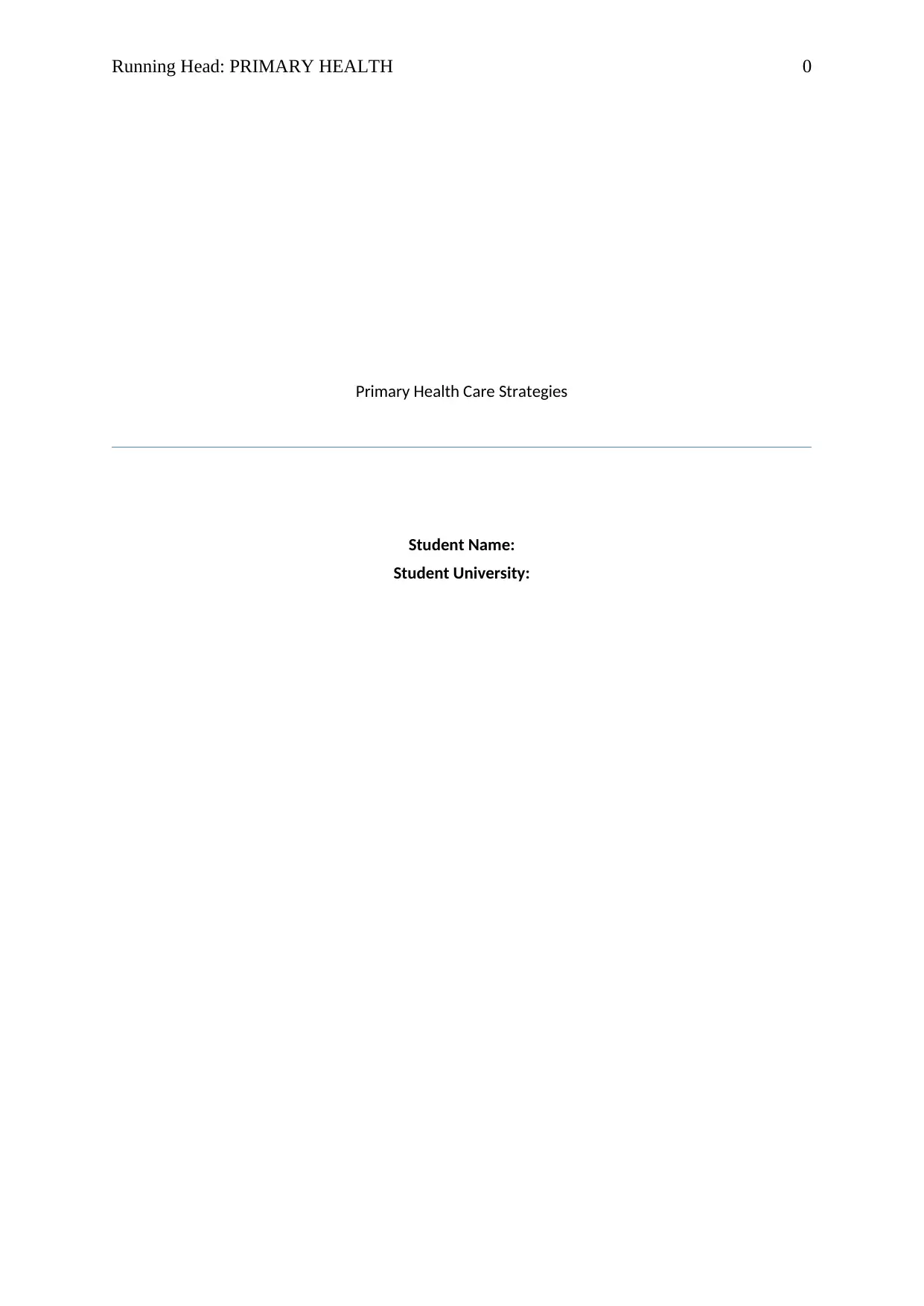
Running Head: PRIMARY HEALTH 0
Primary Health Care Strategies
Student Name:
Student University:
Primary Health Care Strategies
Student Name:
Student University:
Paraphrase This Document
Need a fresh take? Get an instant paraphrase of this document with our AI Paraphraser
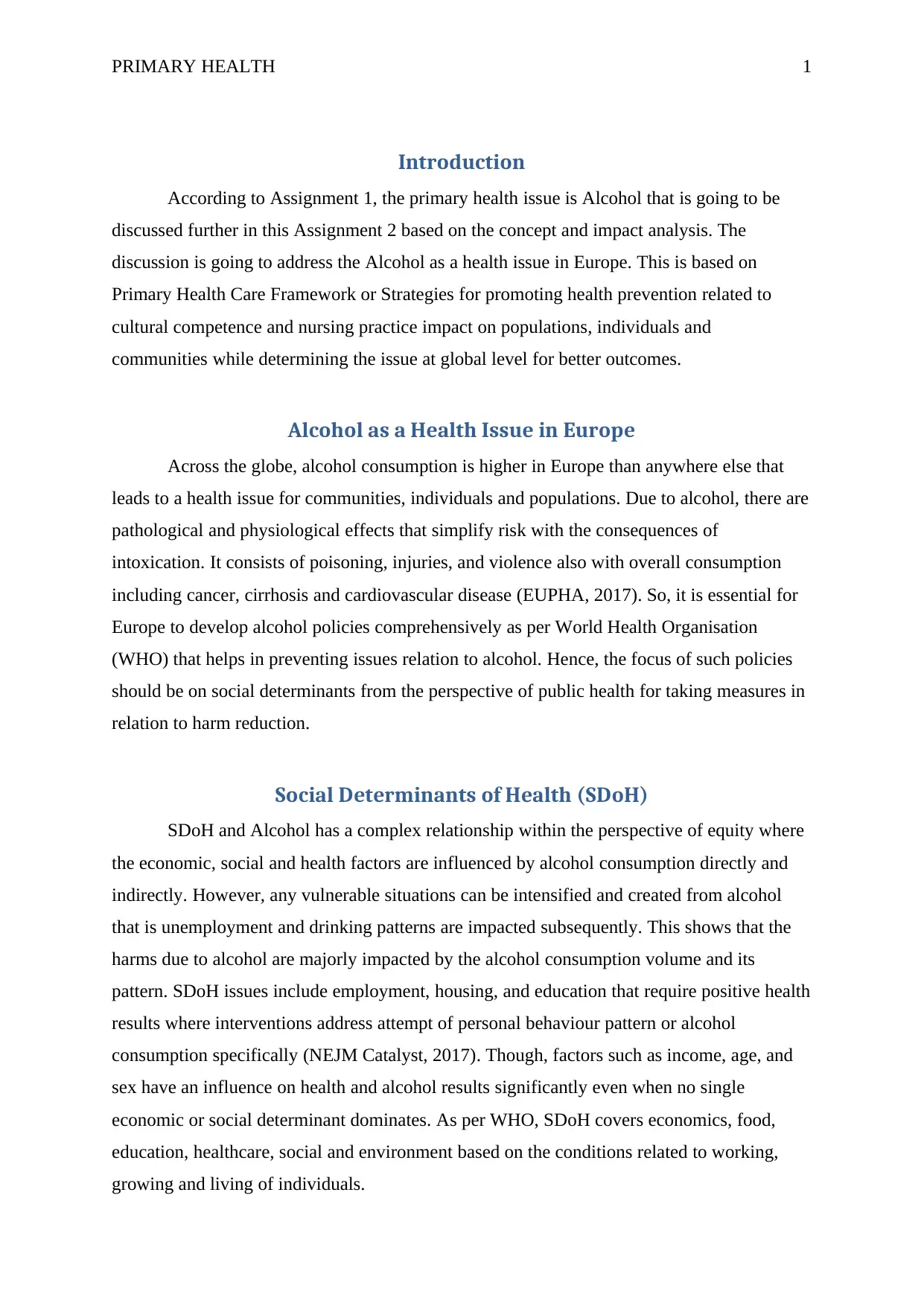
PRIMARY HEALTH 1
Introduction
According to Assignment 1, the primary health issue is Alcohol that is going to be
discussed further in this Assignment 2 based on the concept and impact analysis. The
discussion is going to address the Alcohol as a health issue in Europe. This is based on
Primary Health Care Framework or Strategies for promoting health prevention related to
cultural competence and nursing practice impact on populations, individuals and
communities while determining the issue at global level for better outcomes.
Alcohol as a Health Issue in Europe
Across the globe, alcohol consumption is higher in Europe than anywhere else that
leads to a health issue for communities, individuals and populations. Due to alcohol, there are
pathological and physiological effects that simplify risk with the consequences of
intoxication. It consists of poisoning, injuries, and violence also with overall consumption
including cancer, cirrhosis and cardiovascular disease (EUPHA, 2017). So, it is essential for
Europe to develop alcohol policies comprehensively as per World Health Organisation
(WHO) that helps in preventing issues relation to alcohol. Hence, the focus of such policies
should be on social determinants from the perspective of public health for taking measures in
relation to harm reduction.
Social Determinants of Health (SDoH)
SDoH and Alcohol has a complex relationship within the perspective of equity where
the economic, social and health factors are influenced by alcohol consumption directly and
indirectly. However, any vulnerable situations can be intensified and created from alcohol
that is unemployment and drinking patterns are impacted subsequently. This shows that the
harms due to alcohol are majorly impacted by the alcohol consumption volume and its
pattern. SDoH issues include employment, housing, and education that require positive health
results where interventions address attempt of personal behaviour pattern or alcohol
consumption specifically (NEJM Catalyst, 2017). Though, factors such as income, age, and
sex have an influence on health and alcohol results significantly even when no single
economic or social determinant dominates. As per WHO, SDoH covers economics, food,
education, healthcare, social and environment based on the conditions related to working,
growing and living of individuals.
Introduction
According to Assignment 1, the primary health issue is Alcohol that is going to be
discussed further in this Assignment 2 based on the concept and impact analysis. The
discussion is going to address the Alcohol as a health issue in Europe. This is based on
Primary Health Care Framework or Strategies for promoting health prevention related to
cultural competence and nursing practice impact on populations, individuals and
communities while determining the issue at global level for better outcomes.
Alcohol as a Health Issue in Europe
Across the globe, alcohol consumption is higher in Europe than anywhere else that
leads to a health issue for communities, individuals and populations. Due to alcohol, there are
pathological and physiological effects that simplify risk with the consequences of
intoxication. It consists of poisoning, injuries, and violence also with overall consumption
including cancer, cirrhosis and cardiovascular disease (EUPHA, 2017). So, it is essential for
Europe to develop alcohol policies comprehensively as per World Health Organisation
(WHO) that helps in preventing issues relation to alcohol. Hence, the focus of such policies
should be on social determinants from the perspective of public health for taking measures in
relation to harm reduction.
Social Determinants of Health (SDoH)
SDoH and Alcohol has a complex relationship within the perspective of equity where
the economic, social and health factors are influenced by alcohol consumption directly and
indirectly. However, any vulnerable situations can be intensified and created from alcohol
that is unemployment and drinking patterns are impacted subsequently. This shows that the
harms due to alcohol are majorly impacted by the alcohol consumption volume and its
pattern. SDoH issues include employment, housing, and education that require positive health
results where interventions address attempt of personal behaviour pattern or alcohol
consumption specifically (NEJM Catalyst, 2017). Though, factors such as income, age, and
sex have an influence on health and alcohol results significantly even when no single
economic or social determinant dominates. As per WHO, SDoH covers economics, food,
education, healthcare, social and environment based on the conditions related to working,
growing and living of individuals.
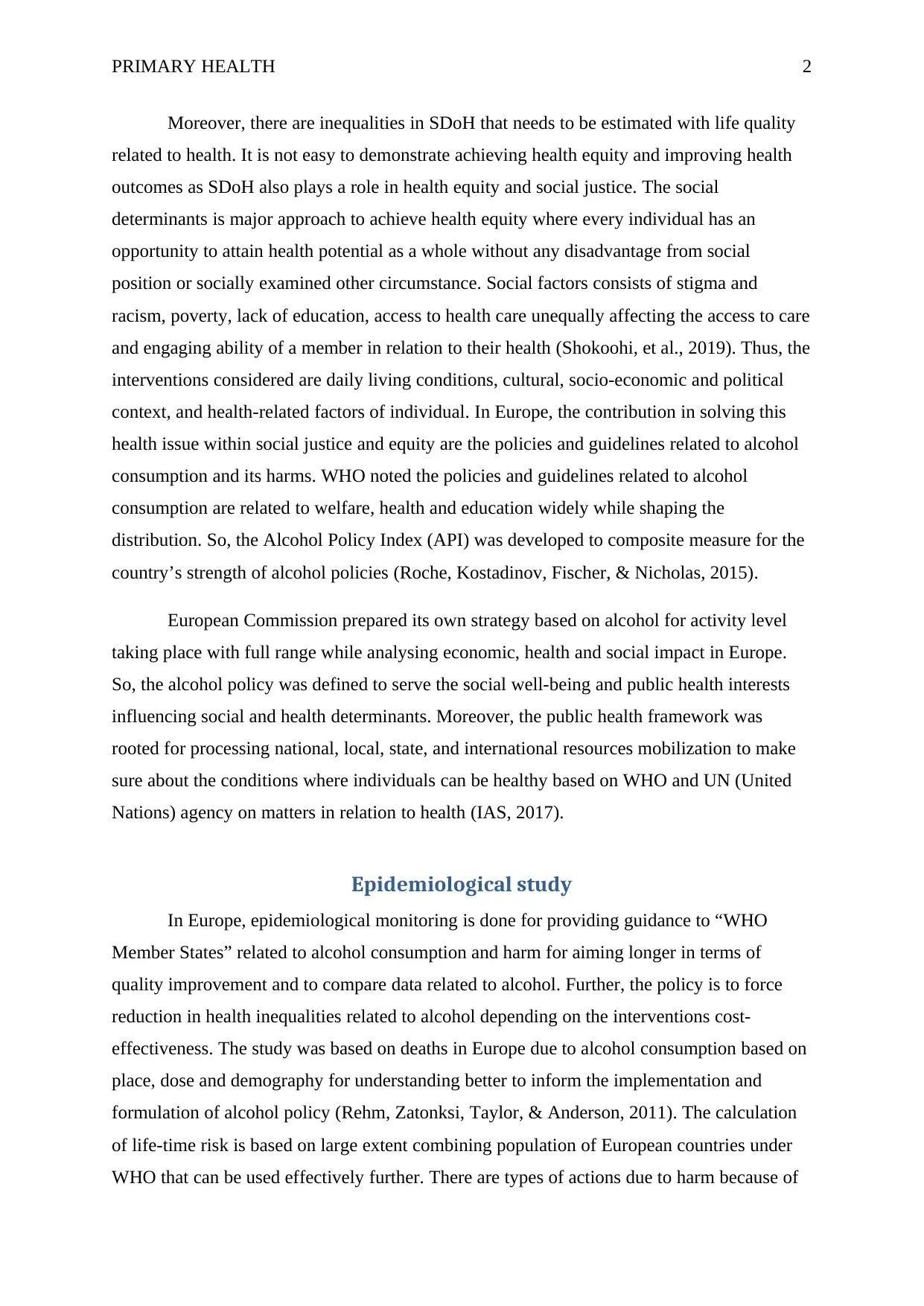
PRIMARY HEALTH 2
Moreover, there are inequalities in SDoH that needs to be estimated with life quality
related to health. It is not easy to demonstrate achieving health equity and improving health
outcomes as SDoH also plays a role in health equity and social justice. The social
determinants is major approach to achieve health equity where every individual has an
opportunity to attain health potential as a whole without any disadvantage from social
position or socially examined other circumstance. Social factors consists of stigma and
racism, poverty, lack of education, access to health care unequally affecting the access to care
and engaging ability of a member in relation to their health (Shokoohi, et al., 2019). Thus, the
interventions considered are daily living conditions, cultural, socio-economic and political
context, and health-related factors of individual. In Europe, the contribution in solving this
health issue within social justice and equity are the policies and guidelines related to alcohol
consumption and its harms. WHO noted the policies and guidelines related to alcohol
consumption are related to welfare, health and education widely while shaping the
distribution. So, the Alcohol Policy Index (API) was developed to composite measure for the
country’s strength of alcohol policies (Roche, Kostadinov, Fischer, & Nicholas, 2015).
European Commission prepared its own strategy based on alcohol for activity level
taking place with full range while analysing economic, health and social impact in Europe.
So, the alcohol policy was defined to serve the social well-being and public health interests
influencing social and health determinants. Moreover, the public health framework was
rooted for processing national, local, state, and international resources mobilization to make
sure about the conditions where individuals can be healthy based on WHO and UN (United
Nations) agency on matters in relation to health (IAS, 2017).
Epidemiological study
In Europe, epidemiological monitoring is done for providing guidance to “WHO
Member States” related to alcohol consumption and harm for aiming longer in terms of
quality improvement and to compare data related to alcohol. Further, the policy is to force
reduction in health inequalities related to alcohol depending on the interventions cost-
effectiveness. The study was based on deaths in Europe due to alcohol consumption based on
place, dose and demography for understanding better to inform the implementation and
formulation of alcohol policy (Rehm, Zatonksi, Taylor, & Anderson, 2011). The calculation
of life-time risk is based on large extent combining population of European countries under
WHO that can be used effectively further. There are types of actions due to harm because of
Moreover, there are inequalities in SDoH that needs to be estimated with life quality
related to health. It is not easy to demonstrate achieving health equity and improving health
outcomes as SDoH also plays a role in health equity and social justice. The social
determinants is major approach to achieve health equity where every individual has an
opportunity to attain health potential as a whole without any disadvantage from social
position or socially examined other circumstance. Social factors consists of stigma and
racism, poverty, lack of education, access to health care unequally affecting the access to care
and engaging ability of a member in relation to their health (Shokoohi, et al., 2019). Thus, the
interventions considered are daily living conditions, cultural, socio-economic and political
context, and health-related factors of individual. In Europe, the contribution in solving this
health issue within social justice and equity are the policies and guidelines related to alcohol
consumption and its harms. WHO noted the policies and guidelines related to alcohol
consumption are related to welfare, health and education widely while shaping the
distribution. So, the Alcohol Policy Index (API) was developed to composite measure for the
country’s strength of alcohol policies (Roche, Kostadinov, Fischer, & Nicholas, 2015).
European Commission prepared its own strategy based on alcohol for activity level
taking place with full range while analysing economic, health and social impact in Europe.
So, the alcohol policy was defined to serve the social well-being and public health interests
influencing social and health determinants. Moreover, the public health framework was
rooted for processing national, local, state, and international resources mobilization to make
sure about the conditions where individuals can be healthy based on WHO and UN (United
Nations) agency on matters in relation to health (IAS, 2017).
Epidemiological study
In Europe, epidemiological monitoring is done for providing guidance to “WHO
Member States” related to alcohol consumption and harm for aiming longer in terms of
quality improvement and to compare data related to alcohol. Further, the policy is to force
reduction in health inequalities related to alcohol depending on the interventions cost-
effectiveness. The study was based on deaths in Europe due to alcohol consumption based on
place, dose and demography for understanding better to inform the implementation and
formulation of alcohol policy (Rehm, Zatonksi, Taylor, & Anderson, 2011). The calculation
of life-time risk is based on large extent combining population of European countries under
WHO that can be used effectively further. There are types of actions due to harm because of
⊘ This is a preview!⊘
Do you want full access?
Subscribe today to unlock all pages.

Trusted by 1+ million students worldwide
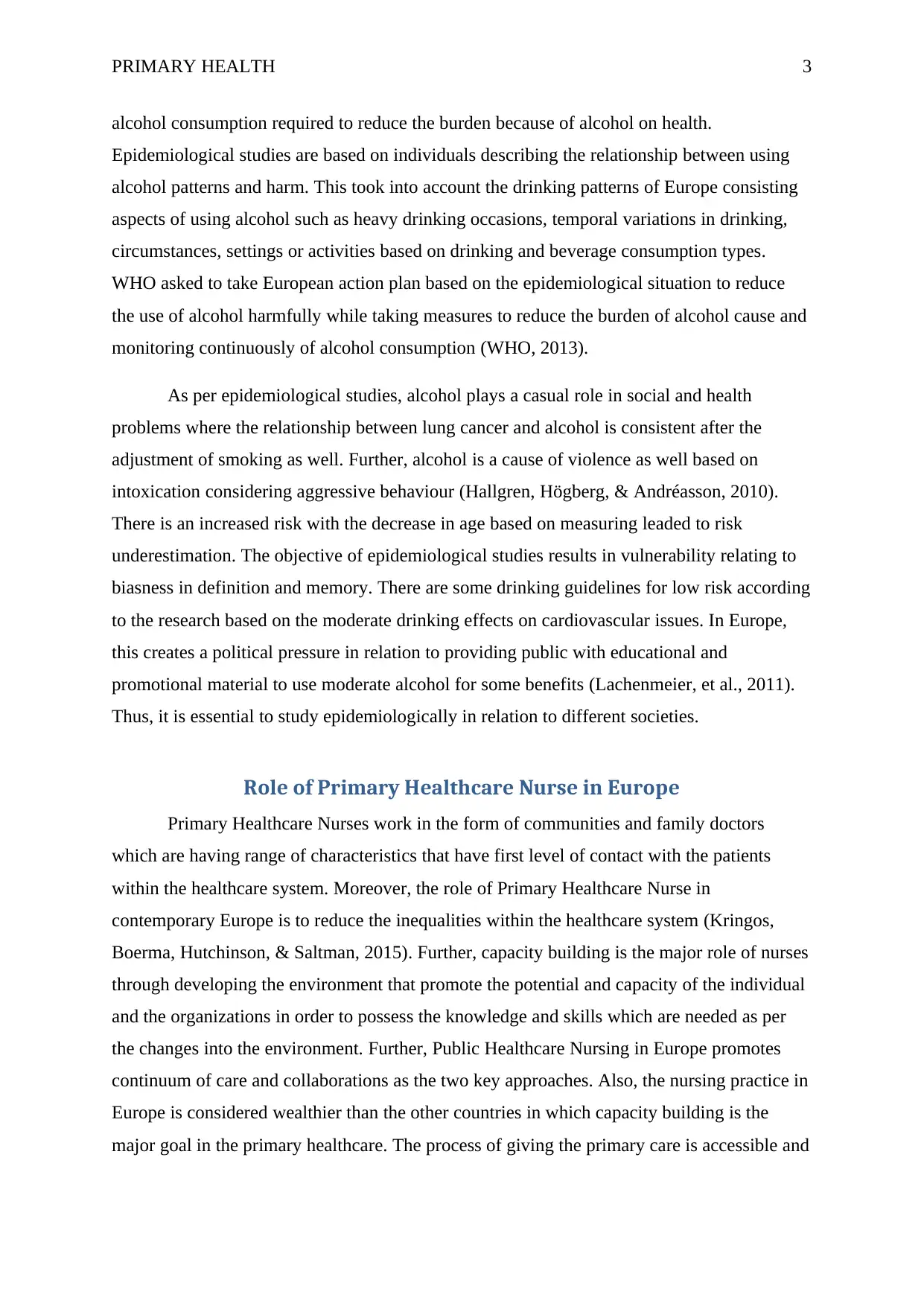
PRIMARY HEALTH 3
alcohol consumption required to reduce the burden because of alcohol on health.
Epidemiological studies are based on individuals describing the relationship between using
alcohol patterns and harm. This took into account the drinking patterns of Europe consisting
aspects of using alcohol such as heavy drinking occasions, temporal variations in drinking,
circumstances, settings or activities based on drinking and beverage consumption types.
WHO asked to take European action plan based on the epidemiological situation to reduce
the use of alcohol harmfully while taking measures to reduce the burden of alcohol cause and
monitoring continuously of alcohol consumption (WHO, 2013).
As per epidemiological studies, alcohol plays a casual role in social and health
problems where the relationship between lung cancer and alcohol is consistent after the
adjustment of smoking as well. Further, alcohol is a cause of violence as well based on
intoxication considering aggressive behaviour (Hallgren, Högberg, & Andréasson, 2010).
There is an increased risk with the decrease in age based on measuring leaded to risk
underestimation. The objective of epidemiological studies results in vulnerability relating to
biasness in definition and memory. There are some drinking guidelines for low risk according
to the research based on the moderate drinking effects on cardiovascular issues. In Europe,
this creates a political pressure in relation to providing public with educational and
promotional material to use moderate alcohol for some benefits (Lachenmeier, et al., 2011).
Thus, it is essential to study epidemiologically in relation to different societies.
Role of Primary Healthcare Nurse in Europe
Primary Healthcare Nurses work in the form of communities and family doctors
which are having range of characteristics that have first level of contact with the patients
within the healthcare system. Moreover, the role of Primary Healthcare Nurse in
contemporary Europe is to reduce the inequalities within the healthcare system (Kringos,
Boerma, Hutchinson, & Saltman, 2015). Further, capacity building is the major role of nurses
through developing the environment that promote the potential and capacity of the individual
and the organizations in order to possess the knowledge and skills which are needed as per
the changes into the environment. Further, Public Healthcare Nursing in Europe promotes
continuum of care and collaborations as the two key approaches. Also, the nursing practice in
Europe is considered wealthier than the other countries in which capacity building is the
major goal in the primary healthcare. The process of giving the primary care is accessible and
alcohol consumption required to reduce the burden because of alcohol on health.
Epidemiological studies are based on individuals describing the relationship between using
alcohol patterns and harm. This took into account the drinking patterns of Europe consisting
aspects of using alcohol such as heavy drinking occasions, temporal variations in drinking,
circumstances, settings or activities based on drinking and beverage consumption types.
WHO asked to take European action plan based on the epidemiological situation to reduce
the use of alcohol harmfully while taking measures to reduce the burden of alcohol cause and
monitoring continuously of alcohol consumption (WHO, 2013).
As per epidemiological studies, alcohol plays a casual role in social and health
problems where the relationship between lung cancer and alcohol is consistent after the
adjustment of smoking as well. Further, alcohol is a cause of violence as well based on
intoxication considering aggressive behaviour (Hallgren, Högberg, & Andréasson, 2010).
There is an increased risk with the decrease in age based on measuring leaded to risk
underestimation. The objective of epidemiological studies results in vulnerability relating to
biasness in definition and memory. There are some drinking guidelines for low risk according
to the research based on the moderate drinking effects on cardiovascular issues. In Europe,
this creates a political pressure in relation to providing public with educational and
promotional material to use moderate alcohol for some benefits (Lachenmeier, et al., 2011).
Thus, it is essential to study epidemiologically in relation to different societies.
Role of Primary Healthcare Nurse in Europe
Primary Healthcare Nurses work in the form of communities and family doctors
which are having range of characteristics that have first level of contact with the patients
within the healthcare system. Moreover, the role of Primary Healthcare Nurse in
contemporary Europe is to reduce the inequalities within the healthcare system (Kringos,
Boerma, Hutchinson, & Saltman, 2015). Further, capacity building is the major role of nurses
through developing the environment that promote the potential and capacity of the individual
and the organizations in order to possess the knowledge and skills which are needed as per
the changes into the environment. Further, Public Healthcare Nursing in Europe promotes
continuum of care and collaborations as the two key approaches. Also, the nursing practice in
Europe is considered wealthier than the other countries in which capacity building is the
major goal in the primary healthcare. The process of giving the primary care is accessible and
Paraphrase This Document
Need a fresh take? Get an instant paraphrase of this document with our AI Paraphraser
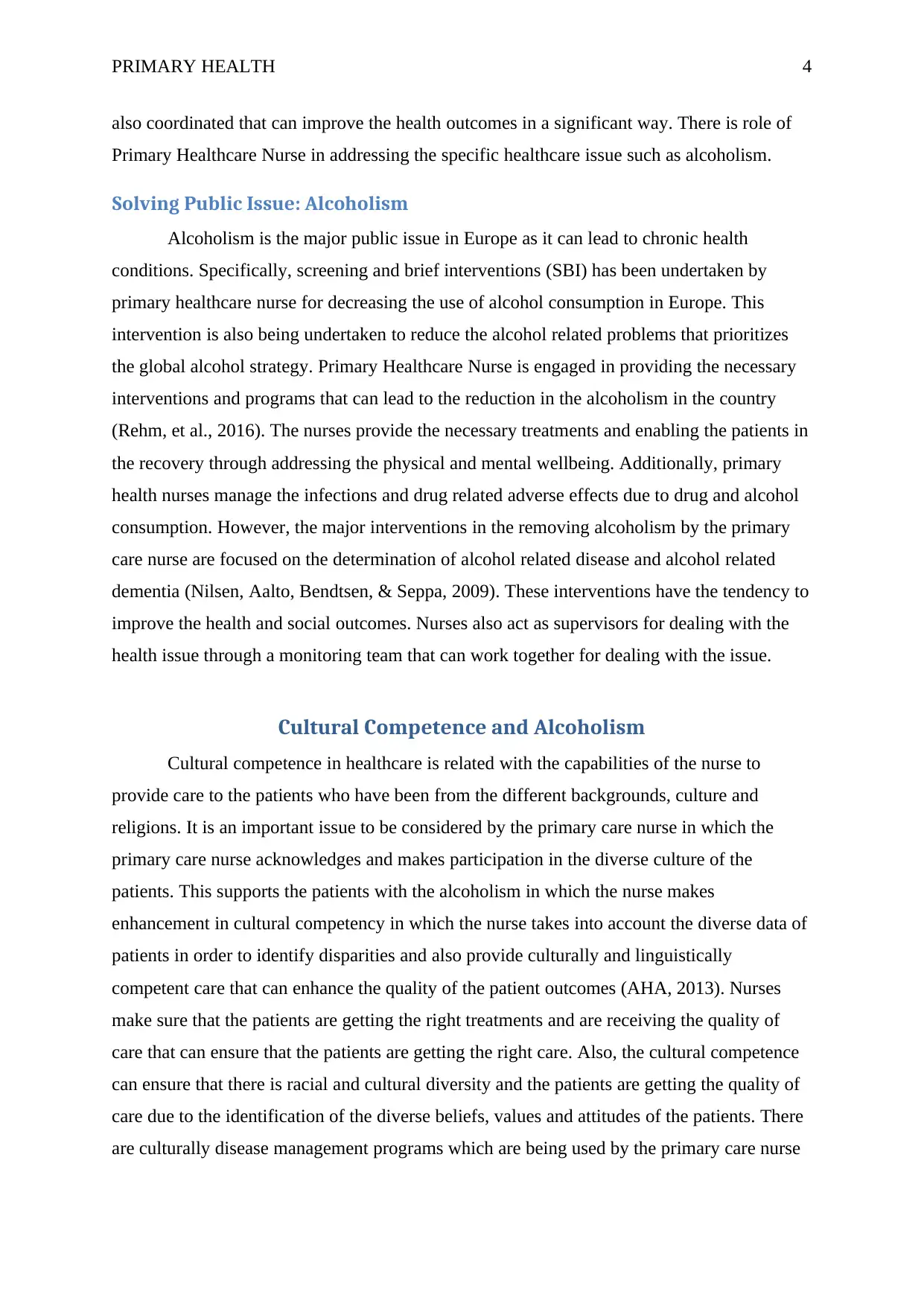
PRIMARY HEALTH 4
also coordinated that can improve the health outcomes in a significant way. There is role of
Primary Healthcare Nurse in addressing the specific healthcare issue such as alcoholism.
Solving Public Issue: Alcoholism
Alcoholism is the major public issue in Europe as it can lead to chronic health
conditions. Specifically, screening and brief interventions (SBI) has been undertaken by
primary healthcare nurse for decreasing the use of alcohol consumption in Europe. This
intervention is also being undertaken to reduce the alcohol related problems that prioritizes
the global alcohol strategy. Primary Healthcare Nurse is engaged in providing the necessary
interventions and programs that can lead to the reduction in the alcoholism in the country
(Rehm, et al., 2016). The nurses provide the necessary treatments and enabling the patients in
the recovery through addressing the physical and mental wellbeing. Additionally, primary
health nurses manage the infections and drug related adverse effects due to drug and alcohol
consumption. However, the major interventions in the removing alcoholism by the primary
care nurse are focused on the determination of alcohol related disease and alcohol related
dementia (Nilsen, Aalto, Bendtsen, & Seppa, 2009). These interventions have the tendency to
improve the health and social outcomes. Nurses also act as supervisors for dealing with the
health issue through a monitoring team that can work together for dealing with the issue.
Cultural Competence and Alcoholism
Cultural competence in healthcare is related with the capabilities of the nurse to
provide care to the patients who have been from the different backgrounds, culture and
religions. It is an important issue to be considered by the primary care nurse in which the
primary care nurse acknowledges and makes participation in the diverse culture of the
patients. This supports the patients with the alcoholism in which the nurse makes
enhancement in cultural competency in which the nurse takes into account the diverse data of
patients in order to identify disparities and also provide culturally and linguistically
competent care that can enhance the quality of the patient outcomes (AHA, 2013). Nurses
make sure that the patients are getting the right treatments and are receiving the quality of
care that can ensure that the patients are getting the right care. Also, the cultural competence
can ensure that there is racial and cultural diversity and the patients are getting the quality of
care due to the identification of the diverse beliefs, values and attitudes of the patients. There
are culturally disease management programs which are being used by the primary care nurse
also coordinated that can improve the health outcomes in a significant way. There is role of
Primary Healthcare Nurse in addressing the specific healthcare issue such as alcoholism.
Solving Public Issue: Alcoholism
Alcoholism is the major public issue in Europe as it can lead to chronic health
conditions. Specifically, screening and brief interventions (SBI) has been undertaken by
primary healthcare nurse for decreasing the use of alcohol consumption in Europe. This
intervention is also being undertaken to reduce the alcohol related problems that prioritizes
the global alcohol strategy. Primary Healthcare Nurse is engaged in providing the necessary
interventions and programs that can lead to the reduction in the alcoholism in the country
(Rehm, et al., 2016). The nurses provide the necessary treatments and enabling the patients in
the recovery through addressing the physical and mental wellbeing. Additionally, primary
health nurses manage the infections and drug related adverse effects due to drug and alcohol
consumption. However, the major interventions in the removing alcoholism by the primary
care nurse are focused on the determination of alcohol related disease and alcohol related
dementia (Nilsen, Aalto, Bendtsen, & Seppa, 2009). These interventions have the tendency to
improve the health and social outcomes. Nurses also act as supervisors for dealing with the
health issue through a monitoring team that can work together for dealing with the issue.
Cultural Competence and Alcoholism
Cultural competence in healthcare is related with the capabilities of the nurse to
provide care to the patients who have been from the different backgrounds, culture and
religions. It is an important issue to be considered by the primary care nurse in which the
primary care nurse acknowledges and makes participation in the diverse culture of the
patients. This supports the patients with the alcoholism in which the nurse makes
enhancement in cultural competency in which the nurse takes into account the diverse data of
patients in order to identify disparities and also provide culturally and linguistically
competent care that can enhance the quality of the patient outcomes (AHA, 2013). Nurses
make sure that the patients are getting the right treatments and are receiving the quality of
care that can ensure that the patients are getting the right care. Also, the cultural competence
can ensure that there is racial and cultural diversity and the patients are getting the quality of
care due to the identification of the diverse beliefs, values and attitudes of the patients. There
are culturally disease management programs which are being used by the primary care nurse
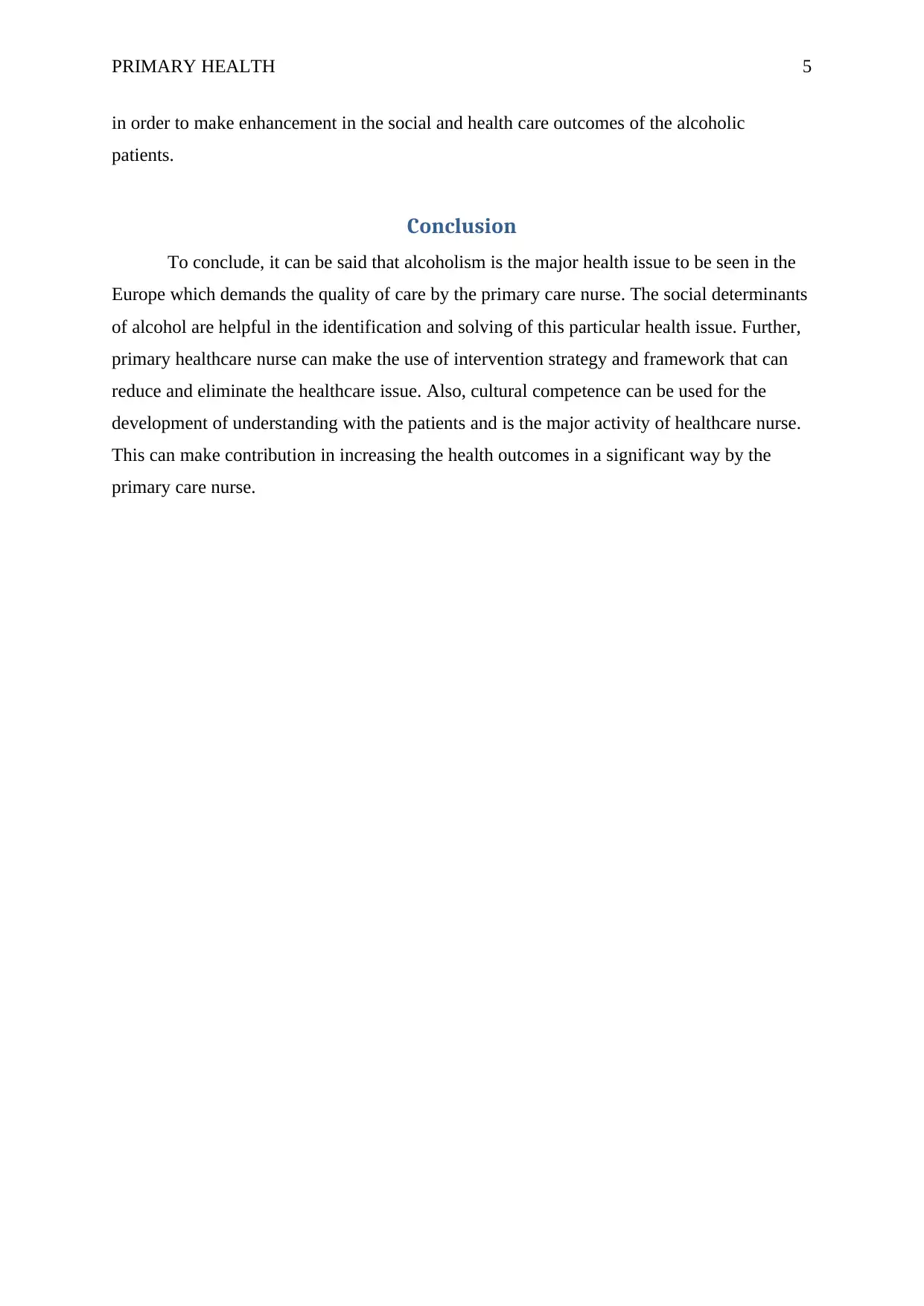
PRIMARY HEALTH 5
in order to make enhancement in the social and health care outcomes of the alcoholic
patients.
Conclusion
To conclude, it can be said that alcoholism is the major health issue to be seen in the
Europe which demands the quality of care by the primary care nurse. The social determinants
of alcohol are helpful in the identification and solving of this particular health issue. Further,
primary healthcare nurse can make the use of intervention strategy and framework that can
reduce and eliminate the healthcare issue. Also, cultural competence can be used for the
development of understanding with the patients and is the major activity of healthcare nurse.
This can make contribution in increasing the health outcomes in a significant way by the
primary care nurse.
in order to make enhancement in the social and health care outcomes of the alcoholic
patients.
Conclusion
To conclude, it can be said that alcoholism is the major health issue to be seen in the
Europe which demands the quality of care by the primary care nurse. The social determinants
of alcohol are helpful in the identification and solving of this particular health issue. Further,
primary healthcare nurse can make the use of intervention strategy and framework that can
reduce and eliminate the healthcare issue. Also, cultural competence can be used for the
development of understanding with the patients and is the major activity of healthcare nurse.
This can make contribution in increasing the health outcomes in a significant way by the
primary care nurse.
⊘ This is a preview!⊘
Do you want full access?
Subscribe today to unlock all pages.

Trusted by 1+ million students worldwide
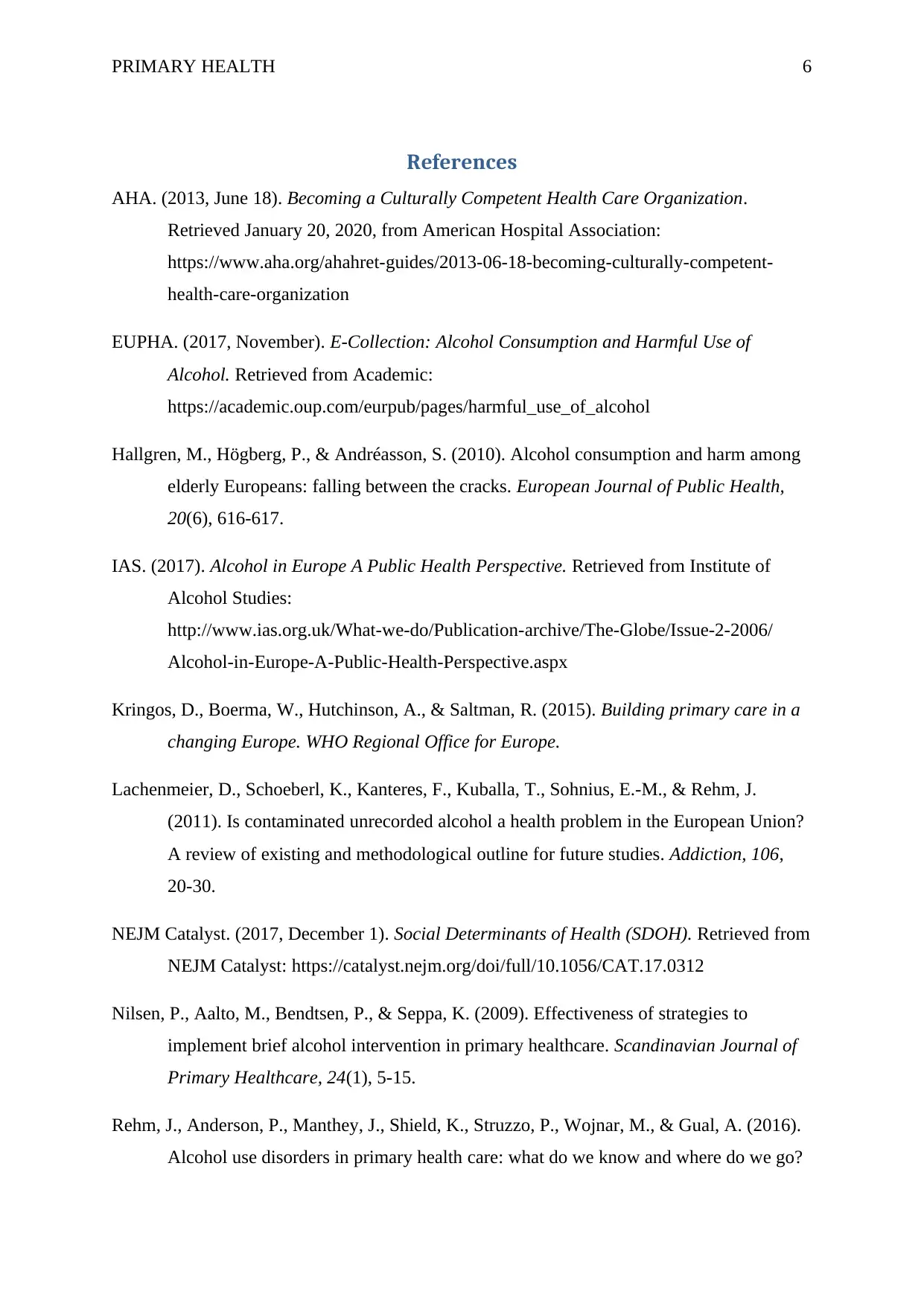
PRIMARY HEALTH 6
References
AHA. (2013, June 18). Becoming a Culturally Competent Health Care Organization.
Retrieved January 20, 2020, from American Hospital Association:
https://www.aha.org/ahahret-guides/2013-06-18-becoming-culturally-competent-
health-care-organization
EUPHA. (2017, November). E-Collection: Alcohol Consumption and Harmful Use of
Alcohol. Retrieved from Academic:
https://academic.oup.com/eurpub/pages/harmful_use_of_alcohol
Hallgren, M., Högberg, P., & Andréasson, S. (2010). Alcohol consumption and harm among
elderly Europeans: falling between the cracks. European Journal of Public Health,
20(6), 616-617.
IAS. (2017). Alcohol in Europe A Public Health Perspective. Retrieved from Institute of
Alcohol Studies:
http://www.ias.org.uk/What-we-do/Publication-archive/The-Globe/Issue-2-2006/
Alcohol-in-Europe-A-Public-Health-Perspective.aspx
Kringos, D., Boerma, W., Hutchinson, A., & Saltman, R. (2015). Building primary care in a
changing Europe. WHO Regional Office for Europe.
Lachenmeier, D., Schoeberl, K., Kanteres, F., Kuballa, T., Sohnius, E.-M., & Rehm, J.
(2011). Is contaminated unrecorded alcohol a health problem in the European Union?
A review of existing and methodological outline for future studies. Addiction, 106,
20-30.
NEJM Catalyst. (2017, December 1). Social Determinants of Health (SDOH). Retrieved from
NEJM Catalyst: https://catalyst.nejm.org/doi/full/10.1056/CAT.17.0312
Nilsen, P., Aalto, M., Bendtsen, P., & Seppa, K. (2009). Effectiveness of strategies to
implement brief alcohol intervention in primary healthcare. Scandinavian Journal of
Primary Healthcare, 24(1), 5-15.
Rehm, J., Anderson, P., Manthey, J., Shield, K., Struzzo, P., Wojnar, M., & Gual, A. (2016).
Alcohol use disorders in primary health care: what do we know and where do we go?
References
AHA. (2013, June 18). Becoming a Culturally Competent Health Care Organization.
Retrieved January 20, 2020, from American Hospital Association:
https://www.aha.org/ahahret-guides/2013-06-18-becoming-culturally-competent-
health-care-organization
EUPHA. (2017, November). E-Collection: Alcohol Consumption and Harmful Use of
Alcohol. Retrieved from Academic:
https://academic.oup.com/eurpub/pages/harmful_use_of_alcohol
Hallgren, M., Högberg, P., & Andréasson, S. (2010). Alcohol consumption and harm among
elderly Europeans: falling between the cracks. European Journal of Public Health,
20(6), 616-617.
IAS. (2017). Alcohol in Europe A Public Health Perspective. Retrieved from Institute of
Alcohol Studies:
http://www.ias.org.uk/What-we-do/Publication-archive/The-Globe/Issue-2-2006/
Alcohol-in-Europe-A-Public-Health-Perspective.aspx
Kringos, D., Boerma, W., Hutchinson, A., & Saltman, R. (2015). Building primary care in a
changing Europe. WHO Regional Office for Europe.
Lachenmeier, D., Schoeberl, K., Kanteres, F., Kuballa, T., Sohnius, E.-M., & Rehm, J.
(2011). Is contaminated unrecorded alcohol a health problem in the European Union?
A review of existing and methodological outline for future studies. Addiction, 106,
20-30.
NEJM Catalyst. (2017, December 1). Social Determinants of Health (SDOH). Retrieved from
NEJM Catalyst: https://catalyst.nejm.org/doi/full/10.1056/CAT.17.0312
Nilsen, P., Aalto, M., Bendtsen, P., & Seppa, K. (2009). Effectiveness of strategies to
implement brief alcohol intervention in primary healthcare. Scandinavian Journal of
Primary Healthcare, 24(1), 5-15.
Rehm, J., Anderson, P., Manthey, J., Shield, K., Struzzo, P., Wojnar, M., & Gual, A. (2016).
Alcohol use disorders in primary health care: what do we know and where do we go?
Paraphrase This Document
Need a fresh take? Get an instant paraphrase of this document with our AI Paraphraser
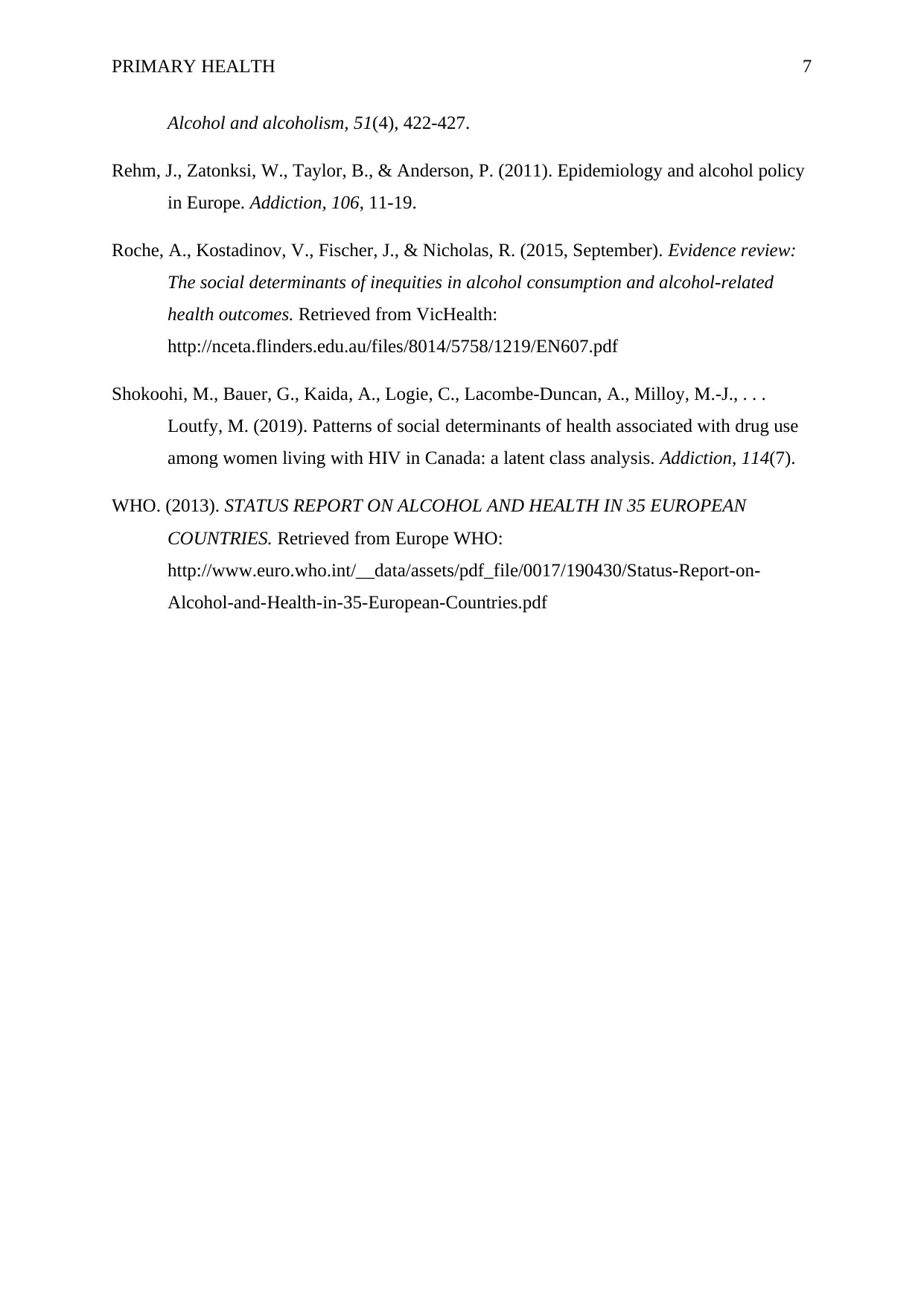
PRIMARY HEALTH 7
Alcohol and alcoholism, 51(4), 422-427.
Rehm, J., Zatonksi, W., Taylor, B., & Anderson, P. (2011). Epidemiology and alcohol policy
in Europe. Addiction, 106, 11-19.
Roche, A., Kostadinov, V., Fischer, J., & Nicholas, R. (2015, September). Evidence review:
The social determinants of inequities in alcohol consumption and alcohol-related
health outcomes. Retrieved from VicHealth:
http://nceta.flinders.edu.au/files/8014/5758/1219/EN607.pdf
Shokoohi, M., Bauer, G., Kaida, A., Logie, C., Lacombe‐Duncan, A., Milloy, M.‐J., . . .
Loutfy, M. (2019). Patterns of social determinants of health associated with drug use
among women living with HIV in Canada: a latent class analysis. Addiction, 114(7).
WHO. (2013). STATUS REPORT ON ALCOHOL AND HEALTH IN 35 EUROPEAN
COUNTRIES. Retrieved from Europe WHO:
http://www.euro.who.int/__data/assets/pdf_file/0017/190430/Status-Report-on-
Alcohol-and-Health-in-35-European-Countries.pdf
Alcohol and alcoholism, 51(4), 422-427.
Rehm, J., Zatonksi, W., Taylor, B., & Anderson, P. (2011). Epidemiology and alcohol policy
in Europe. Addiction, 106, 11-19.
Roche, A., Kostadinov, V., Fischer, J., & Nicholas, R. (2015, September). Evidence review:
The social determinants of inequities in alcohol consumption and alcohol-related
health outcomes. Retrieved from VicHealth:
http://nceta.flinders.edu.au/files/8014/5758/1219/EN607.pdf
Shokoohi, M., Bauer, G., Kaida, A., Logie, C., Lacombe‐Duncan, A., Milloy, M.‐J., . . .
Loutfy, M. (2019). Patterns of social determinants of health associated with drug use
among women living with HIV in Canada: a latent class analysis. Addiction, 114(7).
WHO. (2013). STATUS REPORT ON ALCOHOL AND HEALTH IN 35 EUROPEAN
COUNTRIES. Retrieved from Europe WHO:
http://www.euro.who.int/__data/assets/pdf_file/0017/190430/Status-Report-on-
Alcohol-and-Health-in-35-European-Countries.pdf
1 out of 8
Related Documents
Your All-in-One AI-Powered Toolkit for Academic Success.
+13062052269
info@desklib.com
Available 24*7 on WhatsApp / Email
![[object Object]](/_next/static/media/star-bottom.7253800d.svg)
Unlock your academic potential
Copyright © 2020–2025 A2Z Services. All Rights Reserved. Developed and managed by ZUCOL.





